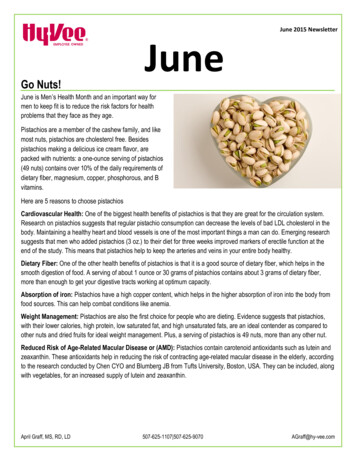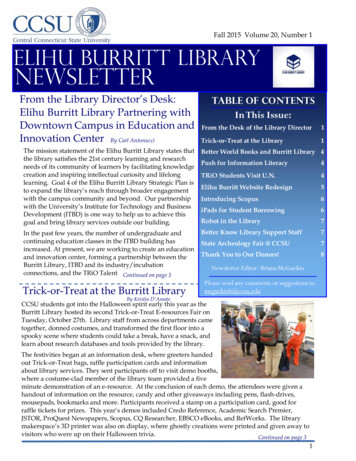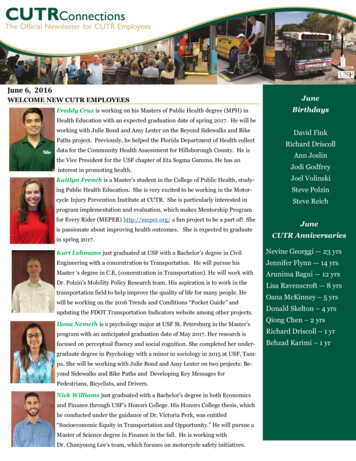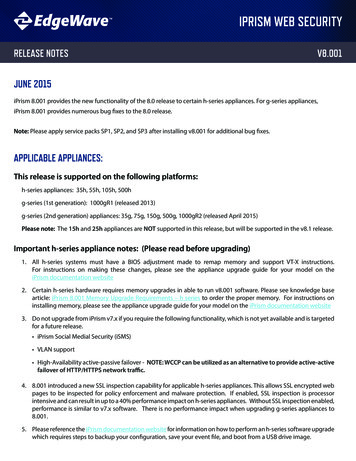
Transcription
June 2015 NewsletterGo Nuts!JuneJune is Men’s Health Month and an important way formen to keep fit is to reduce the risk factors for healthproblems that they face as they age.Pistachios are a member of the cashew family, and likemost nuts, pistachios are cholesterol free. Besidespistachios making a delicious ice cream flavor, arepacked with nutrients: a one-ounce serving of pistachios(49 nuts) contains over 10% of the daily requirements ofdietary fiber, magnesium, copper, phosphorous, and Bvitamins.Here are 5 reasons to choose pistachiosCardiovascular Health: One of the biggest health benefits of pistachios is that they are great for the circulation system.Research on pistachios suggests that regular pistachio consumption can decrease the levels of bad LDL cholesterol in thebody. Maintaining a healthy heart and blood vessels is one of the most important things a man can do. Emerging researchsuggests that men who added pistachios (3 oz.) to their diet for three weeks improved markers of erectile function at theend of the study. This means that pistachios help to keep the arteries and veins in your entire body healthy.Dietary Fiber: One of the other health benefits of pistachios is that it is a good source of dietary fiber, which helps in thesmooth digestion of food. A serving of about 1 ounce or 30 grams of pistachios contains about 3 grams of dietary fiber,more than enough to get your digestive tracts working at optimum capacity.Absorption of iron: Pistachios have a high copper content, which helps in the higher absorption of iron into the body fromfood sources. This can help combat conditions like anemia.Weight Management: Pistachios are also the first choice for people who are dieting. Evidence suggests that pistachios,with their lower calories, high protein, low saturated fat, and high unsaturated fats, are an ideal contender as compared toother nuts and dried fruits for ideal weight management. Plus, a serving of pistachios is 49 nuts, more than any other nut.Reduced Risk of Age-Related Macular Disease or (AMD): Pistachios contain carotenoid antioxidants such as lutein andzeaxanthin. These antioxidants help in reducing the risk of contracting age-related macular disease in the elderly, accordingto the research conducted by Chen CYO and Blumberg JB from Tufts University, Boston, USA. They can be included, alongwith vegetables, for an increased supply of lutein and zeaxanthin.April Graff, MS, RD, LD507-625-1107 507-625-9070AGraff@hy-vee.com
Pistachio “Veggie” BurgersYield: 6 servingsIngredients:1 cup shelled natural American pistachios, finely chopped2 cups coarsely grated zucchini2 cans red kidney beans, drained and mashed½ cup grated Romano cheese (or Parmesan)½ cup dry bread crumbs1 egg½ teaspoon each dried thyme and rosemary1 teaspoon ground black pepper½ teaspoon saltRecipe from American Pistachio GrowersInstructions:1. Combine all ingredients and mix well. Shape into 6patties.2. Place in a grill basket with a fine grid. Grill in over medium coals for 5 – 6 minutes. Flip burger. Cook another 5 – 6 minutes. Servein buns with fixings.Or: Pan-fry “veggie” burgers in lightly oiled skillet over medium-low heat. Cook burger for about four minutes on each side.Salmon with a Pistachio and Basil CrustYield: 4 servingsRecipe from American Pistachio GrowersIngredients:¾ cup bread crumbs½ cup shelled pistachio nuts½ cup freshly grated Parmesan cheese3 tablespoons olive oilLarge handful fresh basilSalt and freshly ground black pepper4 salmon filletsInstructions:1. Place the breadcrumbs, pistachios, basil, Parmesan cheeseand oil in food processor and process for 30 seconds or until just combined.2. Place the salmon fillets on a non-stick baking sheet with raised sides. Press the breadcrumb mixture down gently onto the filletswith the palm of your hand.3. Place in a hot oven 400 F for 15 to 20 minutes or until the salmon is cooked ustJune is Dairy MonthWhether it is milk, yogurt, cheese or ice cream, it is important for you to get three cups of dairy a day (preferably low-fat or fat-free).Why, you ask? Dairy is a great source of: Calcium - the nutrient responsible for building strong bones and for preventing osteoporosis. It is recommended that childrenespecially get the recommended amount because their bones are constantly growing and need the extra calcium. Potassium - with a proper intake, can help you maintain a healthy blood pressure. Vitamin D - an important pairing for calcium as it helps maintain calcium levels and in turn helps build strong bones. High-quality protein - to keep you going through your day.You can sneak dairy into your diet by simply adding a cup of low-fat milk to each meal, a piece of cheese to your sandwich, snackingon a light yogurt or making soup bases with milk instead of water. Incorporate a delicious, low-calorie treat into your diet to get onethird of your dairy intake for the day!April Graff, MS, RD, LD507-625-1107 507-625-9070AGraff@hy-vee.com
April Graff, MS, RD, LD507-625-1107 507-625-9070AGraff@hy-vee.com
Lactose intoleranceEver felt uncomfortable after consuming dairy products? You might be lactose intolerant. But that doesn’t mean you have to avoid dairy products. Byfollowing some simple tips and tricks for management, people with lactose intolerance can feel good about choosing dairy foods first.People with lactose intolerance are unable to fully digest the sugar (lactose) in milk. As a result, they may experience symptoms such as diarrhea,gas and bloating after eating or drinking dairy products. The condition, which is also called lactose malabsorption, is usually harmless, but itssymptoms can be uncomfortable. A deficiency of lactase — an enzyme produced in your small intestine — is usually responsible for lactoseintolerance. Many people have low levels of lactase but are able to digest milk products without problems. If you're actually lactose intolerant,though, your lactase deficiency leads to symptoms after you eat dairy foods.Most people with lactose intolerance can manage the condition without having to give up all dairy foods. Tolerance for lactose varies from person toperson making it a highly individualized condition. Follow these tips from the Midwest Dairy Association for managing lactose intolerance. Sip it: Start with a small amount of milk and slowly work your way up to an amount that doesn’t upset your stomach. Chocolate milk maybe easier on your stomach than regular milk.Try it: Treat yourself to the many great-tasting lactose-free dairy foods available in the dairy case. They are real dairy foods made fromcow’s milk, just without the lactose. Try lactose-free milk, such as Lactaid or Fairlife, lactose-free cottage cheese and lactose-free creamcheese.Stir it: Try eating dairy foods with other solid foods or meals; this helps give your body more time to digest the lactose. Mix milk into soup,have it with cereal or blend it with fruit.Slice it: Top sandwiches or crackers with natural cheeses such as Cheddar, Colby, Monterey Jack, mozzarella and Swiss. These cheesesare low in lactose.Spoon it: Enjoy yogurt. The friendly bacteria help your body break down lactose.Dairy is packed with health benefits, offering calcium for strong bones and high quality protein for healthy muscles. Those and other nutrients areavailable from lactose free milk, cheese and yogurt. The 2010 Dietary Guidelines for Americans recommends three daily servings of dairy. A servingof milk or yogurt is 8 ounces; a serving of cheese is 1.5 ounces of natural cheese or 2 ounces of processed cheese. A visual reminder of a serving ofcheese is four cubes - the size of playing dice.The Great American Milk DriveStop in to either Mankato Hy-Vee location June 8th – 13th to participate in The Great American Milk Drive, a campaign to raiseawareness and money for milk donations to our local food shelves. Your donations stay local, so help us fuel families in our community!April Graff, MS, RD, LD507-625-1107 507-625-9070AGraff@hy-vee.com
Potassium protects your heart and brainWe’ve all heard that reducing sodium is important in lowering blood pressure, but did you know that potassium is a keyplayer too? A new study appearing in the British Medical Journal determined that increasing the amount of potassium inthe diet along with reducing the amount of sodium can lower blood pressure and reduce the risk of stroke.How much potassium should you consume each day? The short answer is 4,700 mg daily. But what does that look like infood? In general, by eating five servings of fruits and vegetables each day, you will more than cover your potassiumrecommendations.In addition to protecting against high blood pressure and stroke, here are five more reasons to get enough potassium.Why potassium is important You literally cannot live without potassium. That’s because thismineral’s main job is to help trigger your heart to contract andsend blood throughout your body. Increasing the amount of potassium in the diet can help not onlyadults, but children as well. As a growing number of youngpeople are being diagnosed with high blood pressure, obesityand type 2 diabetes, it is becoming increasingly important toimprove the diets of children and adolescents, and that meansmaking sure they eat more fruits and vegetables rich inpotassium. Potassium is essential for strong bones and prevention ofosteoporosis. Research shows that women who consume morepotassium have a greater bone mineral density than those who take in only 1,400 to 1,600 mg daily. Adequate levels of potassium are necessary to help prevent nonalcoholic fatty liver disease, a common condition thatplaces people at high risk of developing type 2 diabetes and cardiovascular diseases. You need adequate potassium to help prevent metabolic syndrome and type 2 diabetes.Eat more potassiumTo get more potassium into your diet, here are some rich food sources to add to your daily menu. They include beans(white, Adzuki, soy, kidney, black, lima, pinto), bananas, spinach, acorn squash, dried apricots, baked potatoes, Swisschard, salmon, dates, avocado, raisins, papaya and cantaloupe.It is also important to know your kidney function is normal. If not, potassium levels might accumulate in the body and causeserious problems with your health. Never take potassium supplements without physician guidance. Too much potassium inthe blood stream can be lethal. If you have any underlying condition that causes high potassium, known as hyperkalemia,speak with your doctor about the best diet for you.April Graff, MS, RD, LD507-625-1107 507-625-9070AGraff@hy-vee.com
Attention Dads: Eat your vegetables!There are many sources of influence on children’s eating behaviors. Marketing has a big influence on the foods children eat,but genetics, social relationships, community, schools, economics and culturehelp shape the little eaters of today. Perhaps the greatest influences on whatchildren eat are parents and families. New studies show that dads play a specialrole in forming their children's eating habits – even more so than moms. Dadsmay not always be cooking up a storm or taking main responsibility for thegrocery shopping, but they can serve as a positive role model for their childrenwhen it comes to eating right. Yet, according to the USDA, the majority of fathersfall short in their fruit and vegetable eating. Why? It's not the cost, but becausethey don't care for them.Fathers should praise mom's cooking and eat it with a smile. If dad won't eat it,the kids might not either. Slow and steady wins the race. Assuring kids that there is plenty of food to go around and theywon't “starve to death” when eating slowly is a great lifelong lesson. Fathers can also send a strong message about eatinguntil you are just about full - but not uncomfortable.In some households, mom stresses the nutrition and dad reluctantly goes along with it. If dads don't cook and they are"home alone" charged with feeding the brood, they often turn to less-than-stellar options. Below are tips for cookingchallenged fathers: Bust out some tortillas, pasta sauce and cheese to make quick and simple pizzas in the oven. Show children how to enjoy food in its simplest form. Slice up some apples and cheese, toast some hearty wholegrain bread and serve with hummus or a drizzle of olive oil.Eating behaviors and food choices established in childhood often significantly track into adulthood. We cannotunderestimate the roles of fathers on their children's current and future eating habits. So eat your VEGGIES!Please note: If you received this newsletter in error, my apologies! You may cancel byreplying to this email and typing “REMOVE” in the subject line. If you enjoy this, please passit along to a friend. Tell him/her to send me an email and type in “Subscribe”.April Graff, MS, RD, LD507-625-1107 507-625-9070AGraff@hy-vee.com
Dietary Fiber: One of the other health benefits of pistachios is that it is a good source of dietary fiber, which helps in the smooth digestion of food. A serving of about 1 ounce or 30 grams of pistachios contains about 3 grams of dietary fiber, more than enough











